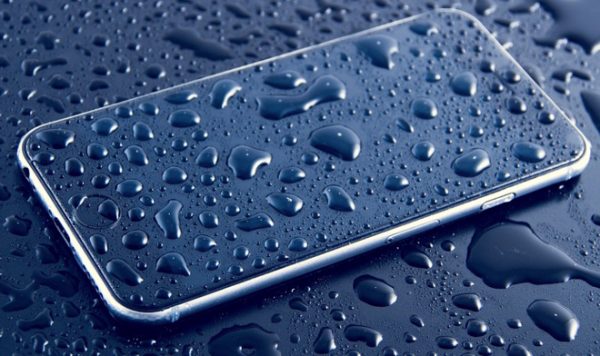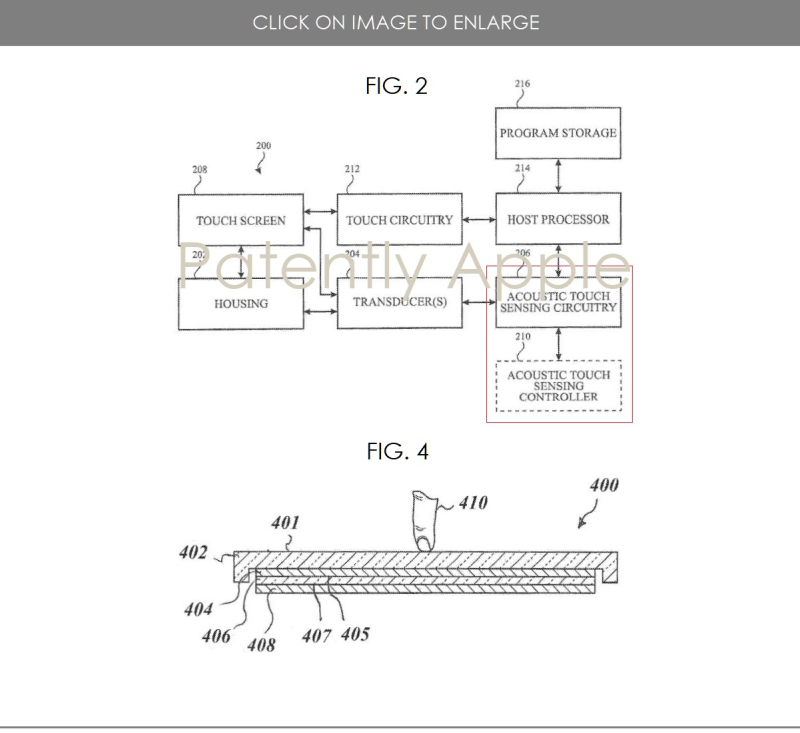Apple Invents iDevice Displays with Ultrasonic Wave Technology that accepts Touch Commands under Water – Patently Apple
Today the US Patent & Trademark Office published a patent application from Apple that relates to system architectures, apparatus and methods for acoustic touch detection and exemplary applications of the system architectures, apparatus and methods. The technology will allow touch commands on an iDevice under water and more.
Apple notes in their patent filing that the position of an object touching a surface can be determined using time of flight (TOF) bounding box techniques, acoustic image reconstruction techniques, acoustic tomography techniques, attenuation of reflections from an array of barriers, or a two-dimensional piezoelectric receiving array, for example.
Acoustic touch sensing can utilize transducers, such as piezoelectric transducers, to transmit ultrasonic waves along a surface and/or through the thickness of an electronic device to the surface.
As the ultrasonic wave propagates, one or more objects (e.g., fingers, styli – Apple Pencil) in contact with the surface can interact with the transmitted wave causing attenuation, redirection and/or reflection of at least a portion of the transmitted wave.
Portions of the transmitted wave energy after interaction with the one or more Objects can be measured to determine the touch location(s) of the one or more objects on the surface of the device.
For example, one or more transducers (e.g., acoustic transducers) coupled behind the display of a device can be configured to transmit an acoustic wave through the thickness of a device (e.g., through the display stack and/or glass surface) to the surface and can receive a portion of the wave reflected back when the acoustic wave encounters a finger or object touching the surface.
The location of the object can be determined, for example, based on the amount of time elapsing between the transmission of the wave and the detection of the reflected wave (e.g., time-of-flight ranging) and/or changes in the amplitude of the reflected wave.
Acoustic touch sensing can be used instead of, or in conjunction with, other touch sensing techniques, such as resistive and/or capacitive touch sensing.
In some examples, the acoustic touch sensing techniques described in Apple’s patent application can be integrated into a display. In some examples, the acoustic touch sensing techniques can be used on a glass surface of a display or touch screen.
In some examples, an acoustic touch sensing system can be configured to be insensitive to contact on the device surface by water, and thus acoustic touch sensing can be used for touch sensing in devices that are likely to become wet or fully submerged in water.
Apple’s patent FIG. 2 below illustrates an exemplary block diagram of an electronic device including an acoustic touch sensing system; FIG. 4 illustrates an exemplary acoustic touch sensing system stack-up
Apple’s patent application 20190235656 that was published today by the U.S. Patent Office was filed back in Q1 2019. Some work on this dates to 2018. Considering that this is a patent application, the timing of such a product to market is unknown at this time.
Some of the Inventors
Ehsan Khajeh: Ultrasonic Sensing Modeling and Hardware Engineer
Moe (Mohammad) Yeke Yazdandoost: Tech Lead at Apple – Lead Sensing Systems Architect
Brian King: Senior Technologist
Marcus Yip: Sensing System Engineer
 About Making Comments on our Site: Patently Apple reserves the right to post, dismiss or edit any comments. Those using abusive language or negative behavior will result in being blacklisted on Disqus.
About Making Comments on our Site: Patently Apple reserves the right to post, dismiss or edit any comments. Those using abusive language or negative behavior will result in being blacklisted on Disqus.








